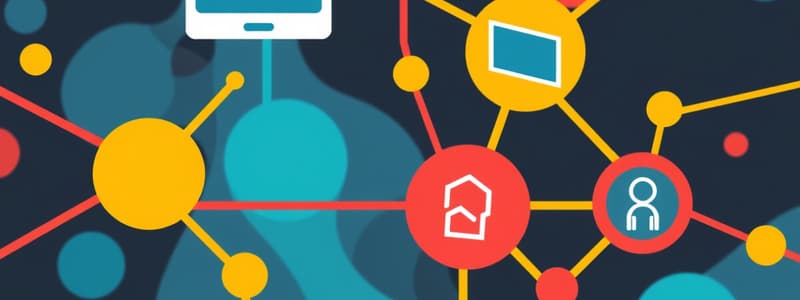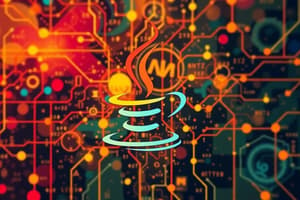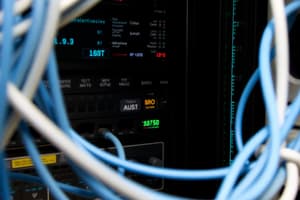Podcast
Questions and Answers
What is a network primarily composed of?
What is a network primarily composed of?
- A single computer with multiple software applications
- Mobile devices without any other connections
- Only computers that are connected to the internet
- Computers and devices that share information (correct)
Which of the following is NOT a type of network node?
Which of the following is NOT a type of network node?
- IoT device
- Microphone (correct)
- Gaming console
- Network switch
What role does a network interface play in a network?
What role does a network interface play in a network?
- It increases internet speed
- It converts data into a transmittable signal (correct)
- It stores data for the network
- It connects multiple networks together
Which component is used primarily for connecting devices in a wireless network?
Which component is used primarily for connecting devices in a wireless network?
What is the purpose of network protocols?
What is the purpose of network protocols?
Which type of cabling is NOT mentioned as a transmission medium?
Which type of cabling is NOT mentioned as a transmission medium?
What is a central connection point in modern networks typically referred to as?
What is a central connection point in modern networks typically referred to as?
What happens if devices use different network protocols?
What happens if devices use different network protocols?
What two parts make up a network address?
What two parts make up a network address?
What does a subnet mask indicate?
What does a subnet mask indicate?
Why is it important for devices to have unique IP addresses?
Why is it important for devices to have unique IP addresses?
What benefit does networking provide regarding resource sharing?
What benefit does networking provide regarding resource sharing?
What does IP version 4 address consist of?
What does IP version 4 address consist of?
What happens if devices are on different subnets?
What happens if devices are on different subnets?
What is the purpose of a central file server in a network?
What is the purpose of a central file server in a network?
What does a value of 255 indicate in a subnet mask?
What does a value of 255 indicate in a subnet mask?
What is a subnet?
What is a subnet?
What advantage does remote management provide in networking?
What advantage does remote management provide in networking?
What fundamental similarity is drawn between a network and a neighborhood?
What fundamental similarity is drawn between a network and a neighborhood?
Why is verifying network IDs important?
Why is verifying network IDs important?
How does networking primarily transform organizational operations?
How does networking primarily transform organizational operations?
What role do email and instant messaging play in networking?
What role do email and instant messaging play in networking?
Study Notes
Introduction to Networking
- All modern computing devices are connected via networks, sharing information seamlessly.
- The internet represents the largest network, composed of interconnected computers.
- Key topics covered: network components, network addressing, benefits of networking.
Networking Components
- Network Nodes/Hosts: Devices such as computers, tablets, mobile phones, gaming consoles, IoT devices, or servers.
- Transmission Media: Connections can be made using twisted-pair cabling, fiber optics, or wireless signals.
- Network Interfaces: Convert digital data into signals suitable for transmission over the selected medium; each device must have one.
- Central Connection Points: Today's networks utilize switches for wired connections and access points for wireless connections.
- Routers: Link multiple networks together, enabling communication across different networks.
- Network Protocols: Define data formatting standards necessary for devices to communicate effectively.
Network Addressing
- Every device on a network has a unique identifier akin to a house address.
- Network addresses consist of:
- Network ID: Comparable to a street name.
- Host ID: Unique building number within the network.
- IP Address: Typically written in IPv4 format, composed of octets (8 bits each), separated by periods (e.g., 192.168.1.50).
- Subnet Mask: Indicates which part of the IP address corresponds to the network and which part corresponds to the host; uses values of 255 (network) and 0 (host).
- Subnetting: Divides large networks into smaller subnets for efficient management and communication.
- Default Gateway: A router that facilitates communication between devices on different subnets.
Networking Benefits
- Resource Sharing: Enables multiple users to access shared resources like printers or storage, reducing costs.
- Centralized Storage: Data can be saved on file servers or network-attached storage, simplifying collaboration and backups.
- Remote Management: Administrators can manage user accounts, data backups, and troubleshooting tasks from a centralized location.
- Enhanced Collaboration: Networking tools like email and instant messaging enable teamwork, regardless of location.
- Improved Efficiency: Centralized administration streamlines processes and reduces the need for individual setups for each device.
Studying That Suits You
Use AI to generate personalized quizzes and flashcards to suit your learning preferences.




